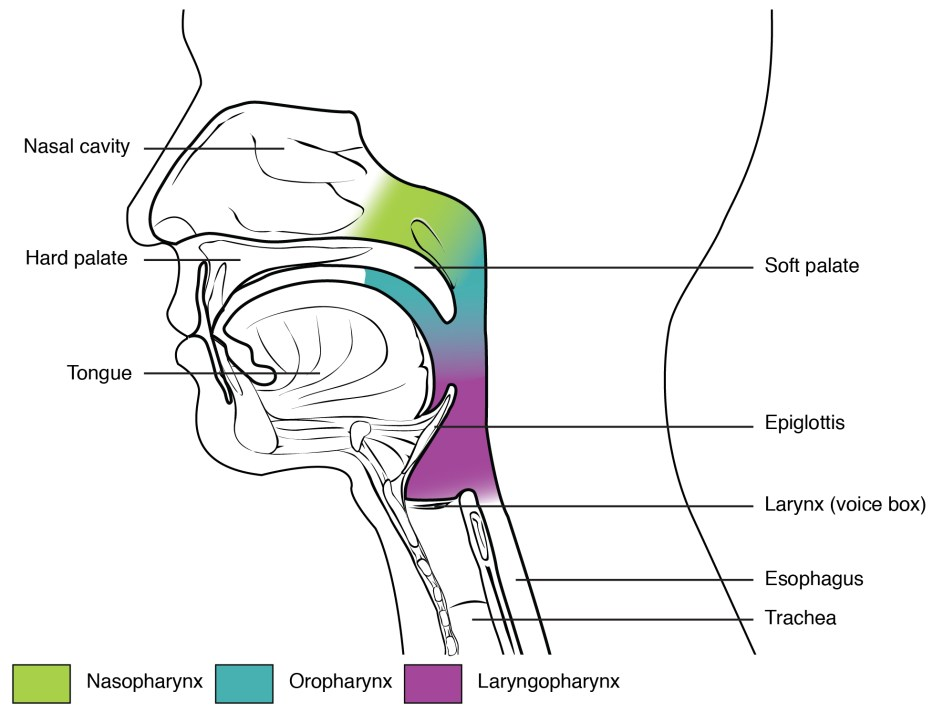These two things are essential to us when voice training. They both have a large stake in controlling our resonance, which is the majority portion of how your voice is gendered.

This is a diagram of the "pharynx" which in simple terms is just the cavities that we use for breathing and speaking in the back of your throat. These are separated into three sections as described by the colored diagram above. For our purposes, we ignore the nasopharynx because it has little impact on our non-nasal speaking resonance (and as far as I understand we have no real way to control it).
The Larynx (Laryngopharynx)
The larynx is very simply the space behind the chin, or behind the laryngeal prominence. That's a fancy word for what is commonly known as the "Adam's apple." It's been named in such a masculine manner due to a testosteronic puberty causing the larynx to lengthen downwards, revealing the bone against the throat. For those who have not undergone a testosteronic puberty, the laryngeal prominence tends to sit right behind your chin, out of sight and often out of reach. When raising or lowering, the laryngeal prominence will move along your throat and is a great indicator of your control over it.
For feminizing voice training, we aim to raise the larynx to attempt to reverse the consequences of a testosteronic puberty. This produces a higher resonance and a more bright and feminine sound. This is done naturally when attempting to produce higher voiceless sounds which serves as the basis for its training.
For masculinizing voice training, we aim to lower the larynx to mimic the effects of a testosteronic puberty as best we can. This will produce a lower resonance and a more dark and masculine sound. This is done naturally when yawning which serves as the basis of its training.
The Oropharynx
The oropharynx is the space directly behind the mouth, or more specifically behind the uvula (you know, that little dangly bit in your throat). This space in my experience is the most influential on the perceived gender of a voice. A testosteronic puberty causes this space to become greater, widening in many directions. Once developed, the manipulation of this space can actually be seen by looking into the mouth with a flashlight.
For feminizing voice training, we aim to constrict the oropharyngeal space to attempt to reverse the consequences of a testosteronic puberty. As with the larynx, this changes the sound to become much more typically feminine. This is done naturally when attempting to produce higher voiceless vowels (I think that's what they are) which serves as the basis for its training. You might notice a bit of overlap with the larynx and this is true, oropharyngeal strength exercises tend to also work the larynx.
For masculinizing voice training, we aim to widen the oropharynx to mimic the effects of a testosteronic puberty as best we can. As with the larynx, this will produce a much more typically masculine sound. This is done naturally when yawning which serves as the basis of its training. This also shares overlap with the larynx, as yawning tends to very much stretch out the vocal spaces.
Notes on pitch
One of the most common mistakes I see trans people making when voice training is stressing over pitch. The pitch is produced by the rate of vibration of the vocal folds and is independent from resonance! Changes in pitch and resonance can sound similar, but they are very different. This is why vocalists don't suddenly shift their voice's gender when they hit a high or low note, they will still sound like their gender because of their resonances.
Pitch is not a great predictor of voice gender, and many men who speak in a high pitch and women who speak in a low pitch exist.
You can probably already reach a pitch that would put you over the line between genders.
On that second one let me challenge you to try it if you don't believe me. I want you to go to any piano app (https://virtualpiano.net) is my favorite or a sine wave generator (https://www.szynalski.com/tone-generator/) which I actually prefer. I want you speak comfortaby for a moment and find a note that roughly matches it in pitch. From there, move two white keys (about 30Hz at a time for the obviously superior sine wave generator) in the direction you want to train. 
(feminizing training goes from left to right, masculinizing right to left | all numbers are in Hertz [Hz])
Odds are everyone reading this can hit both C3 and G3, though maybe not with the resonance they want. I would call D3 the entry to an average masculine pitch with C3 being a much more solid goal, and F3 to be the entry and an average feminine pitch, with G3 being a much more solid goal. It may be dificult to actually speak at these pitches, but that usually is trained as we train for resonance without any extra effort.
If pitch training is absolutely necessary for you, start in a comfortable pitch and practice harmonizing with that pitch. From there you can speak monotonely at that pitch, or instead try and use it as an average. Once you feel confident, move a step up (feminizing) or down (masculinizing) and try and use that new pitch as the basis for your speech. I would keep going until I found a pitch that was only a bit outside of my comfort zone and try to speak there for awhile. If you do this consistently, over the days and weeks you should find yourself feeling comfortable speaking and higher and higher or lower and lower pitches.
